Travels with Grace: City of Parks
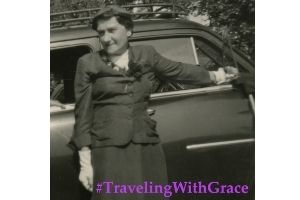
Welcome to this week’s segment of our 2019 #TravelTuesday series: Traveling with Grace. Today we follow along as Grace heads to Brunswick, Hannover, and Hamburg. To read more of Grace’s travels, click here.
September 15, 1929
Sunday. In a very comfortable private car we leave Magdeburg at 9:30 a.m. and ride through Halberstadt, Wernigerode, Blankenburg, Harzburg, Goslar, Hornburg, Wolfenbuttel, Braunschweig (or Brunswick) and Peine before reaching Hannover at 3:30 p.m. It is interesting to drive through these towns especially on Sunday when all the people are enjoying themselves out-of-doors. The architecture is quaint and ornamental, similar in setting but all different in design. Everywhere is manifest the German’s love of flowers, which overflow the window boxes, crowd the gardens, festoon porches and even line the balustrades of bridges to say nothing of the brave array in all the parks. This seems to be a great cattle and sheep country. The farmers are busy with the harvest. The women folk help and park the baby carriages in the fields. Ducks and geese are very plentiful. Bicycles are the favorite vehicle for old and young alike.
We have the good luck to see a wedding procession leaving the church in one of the villages. They all march two by two, first a group of little girls and boys, each of the former carrying a bouquet, the bridge and groom, the children behind holding up the simple white veil, young girls in light dresses and carrying flowers, each on the arm of her escort, the older couples in sober black bringing up the rear.
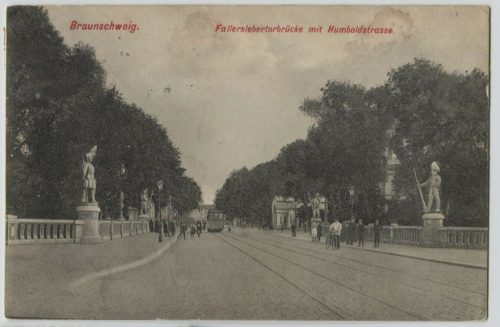
The approach to each town is through the inevitable old city gate with steepled roof. Through Brunswick we make a tour and admire this very rich looking and elegant city, with its castle and other fine public buildings. In the distance are the Harz mountains.
September 16, 1929
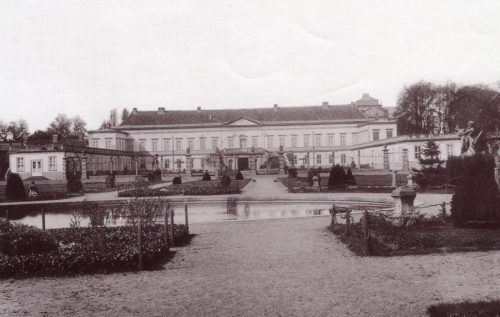
Monday. Hannover is well sur-named “the City of Parks.” There is much open space in every quarter of the city all well kept and ornamented with flowers, trees and stretches of velvety green sward. Extensive and beautiful are the Herrenhausen Gardens with their tall hedges, statues, and fountains in formal style and stately avenues of trees leading to the Palace and Residence. From the windows of our rooms at Kastens we look across to the beautiful Opera House (1 griffon holding up a huge harp on the roof) and at night it is lighted up from top to bottom. The Concert Hall or civic center is another of the city’s ornaments. A large rotunda-shaped structure, it adjoins the athletic park. Here lectures and other entertainments are given and there is a library and reading rooms. The new Town Hall, a building of noble proportions in rococo style, with grassy lawns and a fine approach, commands one’s admiration. The private residences of the wealthy proclaim at once Hannover’s aristocratic lineage (the people here are proud of their historic association with England, but I note here, as elsewhere in Germany, there is little sympathy with Prussia as a whole).
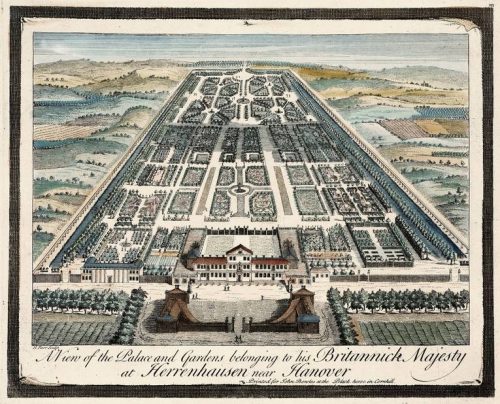
But the picturesque part of the city is in the neighborhood of the Market Platz with its characteristic fountain, statue of Martin Luther with the King and Queen of Hannover, old town hall with wonderful stone carved pillars and cornices and other old buildings colorful with painted wood-work, high peaked roofs and mullioned windows. Leibnitz House, used as a museum, is one of the quaintest and the Potthof is another. There is another old section on the river Leine traversed by small wooden bridges. Some of the small ancient houses actually look like they are in danger of falling down, but I guess they have looked like that for scores of years. The shopping district is very modern and the stores innumerable with merchandise that would do credit to New York or Paris. Some of the new office buildings are designed along very striking futuristic lines with enormous window space, long and wide but never exceeding ten floors in height. The streets are invariably clean, the rubbish being always carefully disposed of. After riding about the city for a couple of hours we motor over to Hildesheim, an hour away.
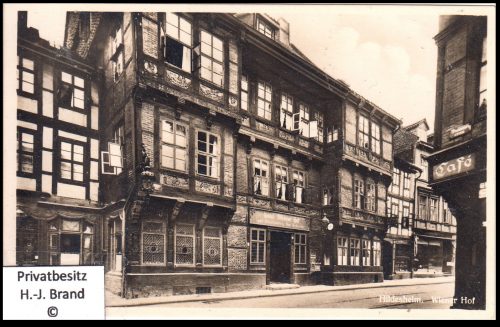
Outside of Rothenberg Hildesheim is the most interesting town, from the standpoint of antiquity, that I have ever seen. We have lunch at the Wienerhof, 320 years old, and very quaint. Afterward we make a tour of inspection which brings rich rewards in the shape of architectural curiosities. The center of interest is of course the Market Place in the center of which is the fountain of Roland with the figure of that knight in bronze. On one side is the old Rathaus and Ratskellar. The façade contains a wooden oriel window; the clock in the tower is surmounted by a horn-blower and head of Judas, the steep stepped gable is ornamented with four figures, the Hildesheimer Jungfrau, a bishop, a senator and an emperor. Up the narrow opening at the side one looks into the old Judengasse.
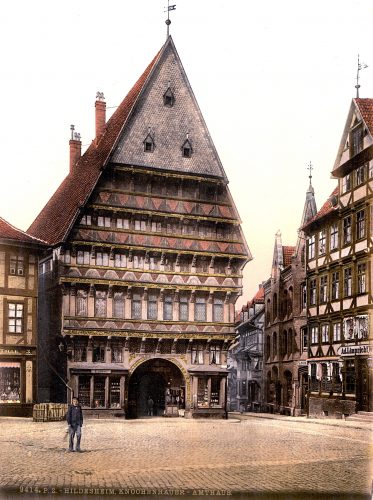
On the other side of this square is the greatest gem of all, the Knochenhauer Authaus or House of the Butcher’s Guild, just 400 years old. It is entirely built of wood and painted in bright colors generously sprinkled with red and gold. Each story leans forward beyond the lower one and the entire façade is richly ornamented with pictures in horizontal rows amplified by verses and excerpts from the proverbs neatly picked out in Old German lettering, while the verses and excerpts from the proverbs neatly picked out in Old German lettering, while the joists which support the projections are elaborately carved and every design is different. For instance there is a row of animals, another of cupids holding various musical instruments, another of shields and coats-of-arms. But the interesting houses are by no means confined to this square. Another curious one, the so-called sugar-loaf hat, flaunts the names of all the virtues and various maxims in Latin. Still others, less ornate, are criss-crossed with wood paneling between which is a sort of brownish linoleum pattern. All are topped by towering, overhanding, pointed roofs usually of red tile. There are two or three very quaint old churches beside the Dom which sleeps away its ripe old age in a quiet little park in which stands the famous thousand year old rose tree. The original city moats have been filled in to form tree lined promenades. One feels an atmosphere of restfulness and peace which permeates the place, but it is by no means dead as there are several thriving industries and a nice commercial area. In the suburbs of these German towns, the people work in the community gardens in which each rents and cultivates his little patch of flowers or vegetables. Tomatoes, which they call Paradise apples, are a great delicacy and they are usually displayed in the shop windows with flowers or fruit.
On our return to Hannover we sit a while in the park. The German people are very friendly and not a little curious. Whenever one sits on a bench it is not long before his neighbor starts up a conversation. Today a Mrs. Wesser forces herself upon our notice and invites herself and son to call on us at the hotel tonight. It is pitiful to witness their eagerness to learn all about America and American ways and very sad to hear their reminiscence of the great war.
September 17, 1929
Tuesday. At 9:30 a.m. we leave Hannover in our comfortable car and ride over splendid roads, through Celle, a very pretty little town, Soltau, etc. In all these villages I notice the nicest little shops which seem well stocked to provide all the needs of the inhabitants and the homes are made gay and attractive with bright colored blooms in gardens, windows and balconies. Harburg is quite a large town, through which we pass before entering Hamburg at 1 p.m. We cross the Elbe over a massive trestle bridge on either end of which is placed the brick façade of a castle or fortress surmounted by two tessellated towers which seem to be the emblem of Hamburg as I notice the same device on the flags. We come to the Hotel Atlantic in time for lunch. It is located on the shore of the Alstar.
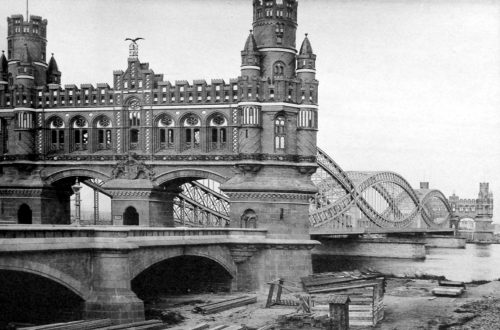
This afternoon we witness a most unusual sight here. The lake is white with the sails of yachts, sloops and schooners that are taking part in a regatta. Enormous crowds are lining the sidewalk to see the Graf Zeppelin whose approach is heralded for four o’clock. Excitement rises as the time draws near and there are many false alarms. Every window for blocks and blocks is filled with eager faces and the people overflow to the roofs and balconies. Every doorstep is thickly populated, autos park along the streets. At last about 6:15 p.m. comes an advance guard of aeroplanes performing stunts as they come on and then the giant dirigible whose aluminum painted sides catch the rays of the setting sun and turn them into tints of mother-of-pearl. It flies very slowly and close to earth, encircling the city several times so that all may have a chance to see. We can read the name and distinguish the lights in the gondola. There are five motor gondolas. To add a touch of amusement, the little blimp, advertising a brand of chocolate, which has been frisking around all afternoon and was responsible for raising many false hopes, flies now over and under the zeppelin giving the illusion of a young and playful whale with its sedate mother swimming about in a vast tank which is the ether. Shouts go up to heaven and every horn and whistle is called into service. The people are bursting with pride.
September 18, 1929
Wednesday. We start with guide this morning to see Hamburg. It is a large city of one million two hundred thousand inhabitants and there is a great deal of traffic, underground and elevated railways, and a vehicular tube under the Elbe. Among the more important buildings we see the Town Hall, beautiful though smoke begrimed, where Dr. Eckener is being tendered a banquet today, the Courts of Justice, various museums and schools, the Borse, the Chile Building, for offices in very modernistic style, St. Michaels church, elegant though plain, the giant Bismarck statue made of huge blocks of granite, the beautiful city park with fine displays of dahlias and roses, not to mention scores of other kinds. We ride all around the Alstar and admire the homes of the merchant princes with their lovely gardens leading down to the lake.
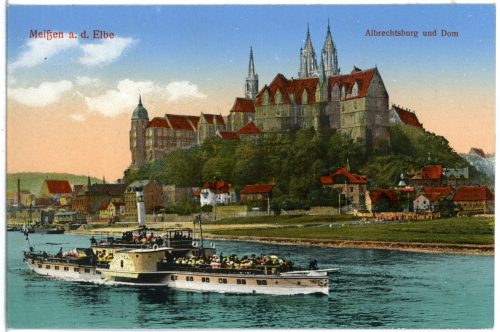
After lunch we motor to Blankenese, formerly a fishing village, where the wealthy citizens have their beautiful summer villas. En route we ride through Altona, an important town of about two hundred thousand, which although there is no great geographical separation, does not belong to the free state of Hamburg which has its own Parliament, but to the state of Schleswig – Holstein, and formerly to Denmark. From Blankenese we ride up the Sulberg for fine panorama of the Elbe stretching out like a sheet of silver below. All about are scenes of activity, as these are great shipping and fishing ports.
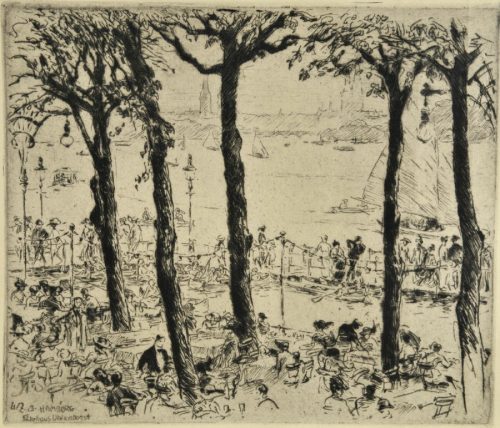
Tonight we dine at the Uhlenhorster Fahrhaus on the Alster most fashionable restaurant in Hamburg. It is quite a pretty sight in the garden, the tables spread beneath the trees, band playing, full moonlight on the water, balmy air, the quay lined so thickly with canoes that every now and then one or two capsize as others try to squeeze along the side. Yachts and lake steamers cast red and green reflections from their headlights on the water as they ply up and down. The crowd has reached goodly proportions by 10:30 when the fireworks began. The lights are turned out and we enjoy a lovely pyrotechnic display. All kinds of sky rockets and pinwheels are shot high up over the middle of the lake and there are some wonderful set pieces, one of which, marked “Viva Chile” flashes the seal and emblem of that state. Others represent colored fountains and finally comes the surprise of the evening. In honor of Dr. Eckener, who is guest at a banquet here tonight, an exact replica of the Graf Zeppelin is set off in an illuminated piece and it actually flies through the air nosing upward for the space of a few yards. When the display is over the enthusiastic crowd gathers around the restaurant entrance and cheers the hero as he departs waving his hat to all.
September 19, 1929
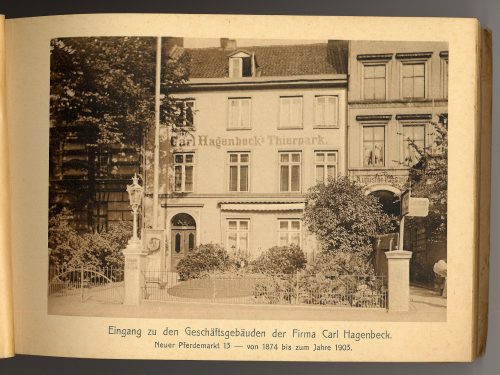
Thursday. We spend today in Carl Hagenbeck’s Park. The chauffeur pushes me about in a wheel chair. Some of the wild animals, including the lions, are not confined in cages, but are safe-guarded by means of ditches and undercut rock work so that they appear to move about freely as they would in their natural haunts. The artificial goat hill is particularly happy in the illusion that it creates of a natural setting where the animals are of the same color as the background. In one ravine are some odd varieties of ruminants. The bird and monkey collections are interesting and amusing to me as are the black, yellow and white penguins who stick their heads up in a line vertical with their bodies, emit an unearthly screech and immediately drop them again. In the snake house we see the little reptiles being fed with maggots and here is also a large collection of insects. The elephants are chained by their feet but they beg for food by stretching out their trunks to all comers. The walls are lined with brilliantly plumaged parrots squawking on their perches.
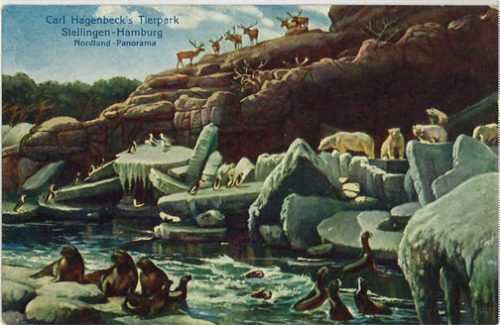
Hagenbeck has a pretty home in the park in the midst of flower gardens. The rose garden is ornamented with two huge Japanese vases. There are large bronze ornaments and red gates with Japanese characters in gold. In another part of the park are constructed cement figures of prehistoric animals on a gigantic scale. Various sections of the park are separated by lakes and streamlets. There is a fine restaurant where we have our tea and a good orchestra is playing. We see the show put on by some imported Zulus with a few Arab horses and camels, all looking quite savage. After this we see the trained lions, tigers, brown and polar bears and pumas put through their stunts on the stage by their trainer. We see huge sea lions and a sea elephant in their tanks. Also many giraffes, buffaloes, zebras, flamingoes, ostriches, and all sorts of wild fowl. The entrance to the park is worthy of mention. It is surmounted by life sized figures of animals, an Indian and Zulu in bronze.
Thanks for reading “Traveling with Grace,” a series where we’re sharing (and annotating) posts from the travel diaries of Grace Amelia Hecht, native Baltimorean, b. 1897 and d. 1955. As mentioned in my introductory post transcription errors sometimes occur and I’ve made my best guesses where possible, denoted by [brackets]. – Rachel Kassman, marketing manager
